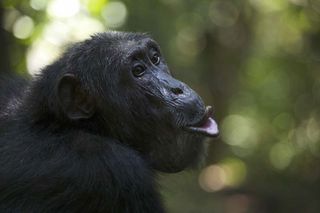what is the closest relative to modern humans
Human Evolution: Our Closest Living Relatives, the Chimps

Editor's Annotation: This is Part v in ten-part series LiveScience series on the origin, development and futurity of the human species and the mysteries that remain to be solved.
As scientists try and solve and mystery of how we originated, an invaluable source of clues is the chimpanzee.
Of course, humanity did not evolve from the chimpanzee, which has spent time evolving on its own path for millions of years from our last mutual ancestor, but every bit we have. Still, chimps are our closest living relatives — we share 98.8 percentage of their DNA — and new research is continuing to shed light on simply how similar nosotros remain, promising to yield insights into the roots nosotros both stem from.
Shut but non as well close
Genetic testify suggests the ancestors of humans and chimpanzees diverged roughly four one thousand thousand years agone. The relative size of the chimp encephalon matches most of our extinct relatives, for a long time suggesting our ape cousin might be an platonic identify to glimpse humanity'south origins.
New show suggests, however, that our last common ancestor may not have looked every bit chimp-like as earlier idea. The fossil Ardipithecus ramidus, dating iv.4 meg years old, which may very well be ancestral to both homo and chimpanzee lineages, walked neither like us or chimps, possessing instead an intermediate form of walking.
In improver, Ardipithecus seemed to have possessed canines that are reduced in size, while male chimps accept large tusk-like canines used as weapons for threatening and sometimes attacking other males. This may propose that chimpanzees behaved significantly differently from our final common antecedent.
Still shut plenty
Nonetheless, humans keep much in common with chimpanzees.
"Emotionally and socially, the psychology of chimps is very similar to humans," said primatologist Frans de Waal at Emory University in Atlanta.
For instance, he noted, chimps have shown they can help unrelated chimps and human strangers at personal cost without credible expectation of personal gain, a level of selfless behavior ofttimes claimed as unique to humans. They also brandish what many scientists dub civilization, with groups of chimpanzees socially passing on dozens of behaviors such as tool kits from generation to generation that are distinct from ones seen in other groups.
"The big divergence I see going for u.s. is linguistic communication," de Waal said. "They tin learn a few symbols in labs, but information technology'southward not impressive in my opinion compared to what even a young child can do. They don't really symbolize like we do, and linguistic communication is a big divergence that influences everything else that you do — how you communicate, basic social interactions, all these go far more complex."
Brand honey, not war?
Equally gentle as our closest living relatives can be, chimps also can be quite violent in the wild, raping, killing and warring confronting their rivals. "They don't like cooperating with strangers, that'due south for sure," de Waal said.
Harvard biological anthropologist Richard Wrangham has suggested this pattern of violence may have been office of humanity'south legacy also for millions of years. However, de Waal noted that based what the canines of Ardipithecus suggest, "chimpanzees may be specialized in that regard. Information technology's only with the special contempo man atmospheric condition of settlement and agriculture that gave u.s.a. the incentive to worry about wealth, leading the states to get warriors that manner."
Instead, de Waal suggests looking at our other close relative, the bonobos, the chimpanzee-similar great apes once dubbed "pygmy chimpanzees" that are more than playful, frequently resolving conflicts with sexual activity instead of violence. "Other scientists accept speculated that bonobos may be the more than ancestral blazon," he said.
Father figures
In the example of either chimpanzees or bonobos, humans are distinct in that fathers are oftentimes involved in child care. "Gorilla males protect the females and offspring, but that's pretty much information technology," de Waal said.
"That'south what's very special nigh human society — the males are involved in caring for offspring," he added. "It'due south possible this is because nosotros moved from the forests, where if a predator comes along, you can simply climb a tree. In that location's more than danger to deal with when we came downwards from the trees, and so that might have been the trigger for males to get involved."
- Top 10 Things That Make Humans Special
- Peak x Mysteries of the Kickoff Humans
- Poll: Your View of Human Evolution
andrewswhostell1946.blogspot.com
Source: https://www.livescience.com/7929-human-evolution-closest-living-relatives-chimps.html
0 Response to "what is the closest relative to modern humans"
Post a Comment